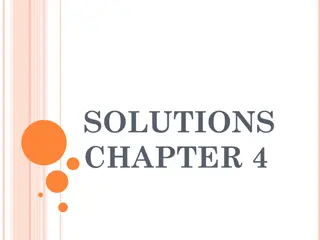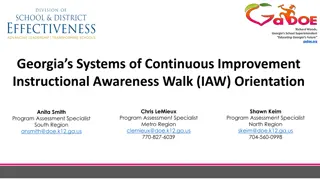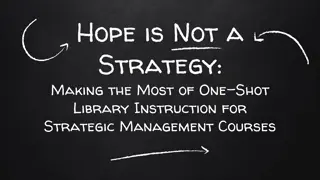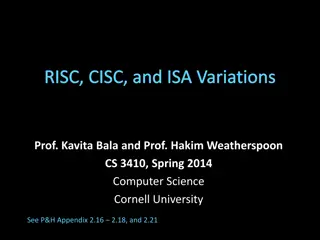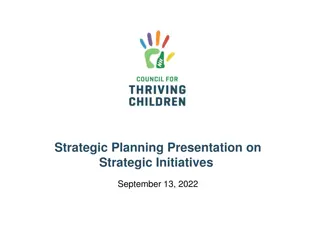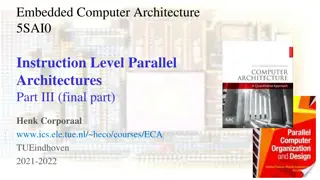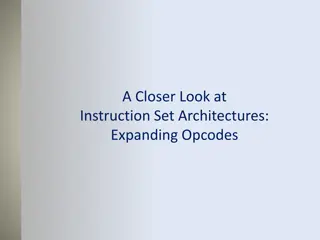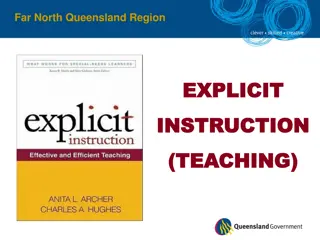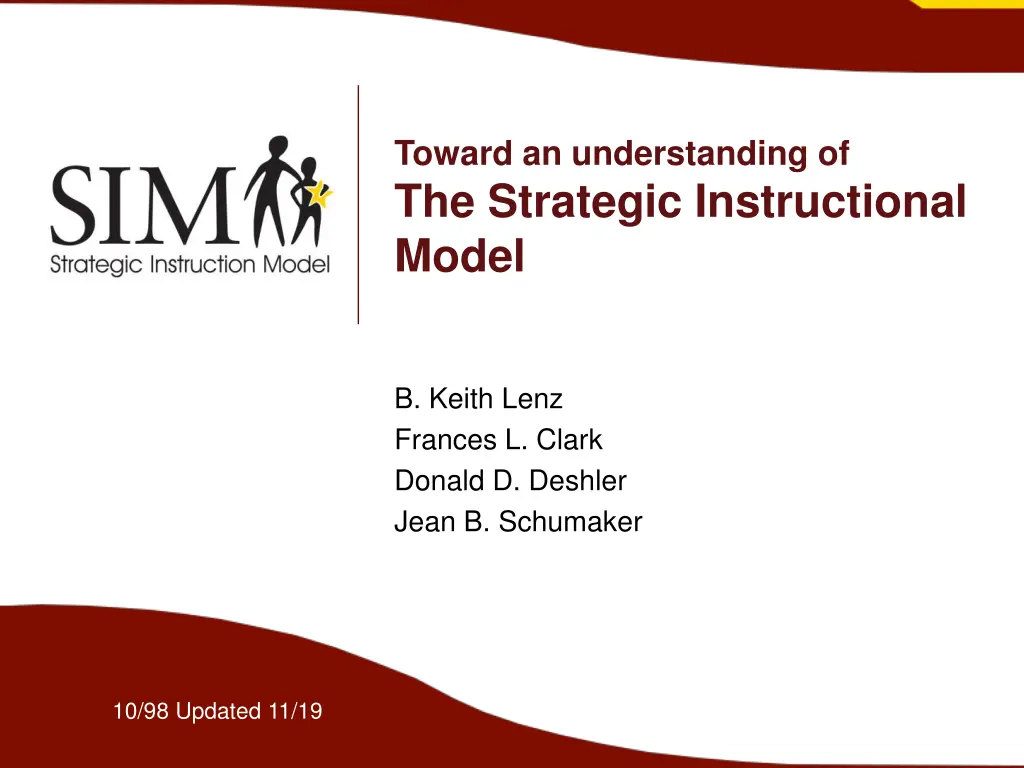
Understanding the Strategic Instructional Model for Academic Success
Dive into the Strategic Instructional Model designed by B. Keith Lenz, Frances L. Clark, Donald D. Deshler, and Jean B. Schumaker. Explore how this model addresses academic, social, motivational, and executive aspects of learning to support students in achieving success both in and out of school.
Download Presentation

Please find below an Image/Link to download the presentation.
The content on the website is provided AS IS for your information and personal use only. It may not be sold, licensed, or shared on other websites without obtaining consent from the author. If you encounter any issues during the download, it is possible that the publisher has removed the file from their server.
You are allowed to download the files provided on this website for personal or commercial use, subject to the condition that they are used lawfully. All files are the property of their respective owners.
The content on the website is provided AS IS for your information and personal use only. It may not be sold, licensed, or shared on other websites without obtaining consent from the author.
E N D
Presentation Transcript
Toward an understanding of The Strategic Instructional Model B. Keith Lenz Frances L. Clark Donald D. Deshler Jean B. Schumaker 10/98 Updated 11/19
Demands and Expectations In School and Out of School Settings Academically, students must gain information from books and lectures and demonstrate this information in writing and on tests. Socially, students must follow rules and interact appropriately with peers and adults. Motivationally, students must set, plan for, and carryout short and long-term goals. Executively, students must independently solve problems and generalize learning across situations.
Characteristics of Low Achievers Academically, low achievers plateau in basic skill areas and have difficulty studying, completing assignments, and organizing information. Socially, low achievers have difficulty interacting with peers and adults and are likely to engage in rule-breaking behavior. Motivationally, low achievers do not see the benefits of their efforts and have difficulty setting and attaining goals. Executively, low achievers often do not generalize new learning and have difficulty with the problem solving process.
B = E x I Behavior = Environment x Individual Effective Strategic Individuals = x Traditional Settings Efficient Strategy instruction supported by strategic environs
The Strategic Instruction Model A Strategic Curriculum related to meeting the demands that students must face in and out of school Strategic Instructional Procedures to promote strategy and content acquisition and generalization A Strategic Environment to facilitate and enhance strategic learning performance
A Strategy An individual s approach to a task Includes how a person thinks and acts Focuses on a performance continuum Concentrates on results of efforts
Strategic Instruction .is instruction in how to learn and perform.
Lion Orange Fish Cherry Chevrolet Horse Ford G M C Banana Zebra Apple Volkswagon Lemon Dodge Frog
CONTENT SKILLS STRATEGIES
CONTENT STRATEGIES SKILLS
Strategically-Enhanced Instructional Environment CONTENT STRATEGIES SKILLS
Strategically-Enhanced Instructional Environment CONTENT STRATEGIES SKILLS
Philosophical underpinnings of SIM Most LA adolescents can learn to function independently in mainstream settings. The role of the support class teacher is to teach strategies that will enable them to be independent learners and performers. The role for the content teacher is to deliver subject matter in a manner that can be understood and remembered by LA adolescents. Adolescents should have a voice in deciding what strategies they will learn.
Components Strategic Instruction Strategic Curriculum Strategic Environment
Strategic Curriculum Addresses demands related to success across settings Focuses on meeting thask demands, not simply learning a strategy Addresses the needs of a majority of low-achieving and at-risk studets.
Strategic Curriculum Learning Strategies Social Skills Strategies Motivation Strategies Executive Strategies
Strategic Curriculum Learning Strategies Acquisition Storage Expression/Demonstration of Competence
Example: The Error Monitoring Strategy An expression and Demonstration of Competence Strategy Write on every other line using PENS Read the paper for meaning Interrogate yourself using the COPS questions Take the paper to someone for help Execute a final copy Reread your paper Capitalization Overall Appearance Punctuation Spelling {
Strategic Curriculum Social Skills Strategies Conversation Friendship Getting Along Problem Solving
Strategic Curriculum Motivation Strategies Goal Evaluation Goal Specification Goal Actualization
Strategic Curriculum Executive Strategies Selection Adaptation Development Application
Components Strategic Instruction Strategic Curriculum Strategic Environment
Strategic Instruction Provides for direct explanation of strategies Takes into account students lack of strategies Attends to the stages of learning Incorporates principles of effective instruction Requires active student participation and involvement Prompts student independence
Strategic Instruction Acquisition Generalization Strategic Teaching Behaviors Content Enhancement
Acquisition Pretest Gain Commitment Describe the Strategy Model the Strategy Controlled Practice Advanced Practice Post Test Generalization
Generalization Orientation Activation Adaptation Maintenance
Strategic Teaching Behaviors Performers Reactors Organizers Monitors Informers Sizzlers Enhancers
Content Enhancement Planning Routines Devices
Components Strategic Instruction Strategic Curriculum Strategic Environment
A Strategic Environment Requires teaming between teachers, students, parents and other professionals Stresses importance of progress, performance, and generalization feedback Focuses on the change and development process Promotes effective organizationof time and resources Facilitates students interdependence
Strategic Environment Teaming Management Evaluation Development
Teaming Cooperative Planning and Teaching Family Enrichment Home-School Communication
Management Techniques Resource Management Rule Management Time Management Instructional Management
Evaluation Techniques Student Evaluation Program Evaluation Instructional Evaluation
Development Techniques Program Development Curriculum Development
Components of SIM Strategic Curriculum Strategic Instruction Strategic Environment Learning Strategies Social Skill Strategies Motivation Strategies Executive Strategies Acquisition Generalization Strategic Teaching Behaviors Content Enhancement Procedures Teaming Management Evaluation Development
Implementation Mainstream Classes Support Class TEACHER TEACHER Cooperative Planning STUDENT STUDENT Generalization Support Systems Administration - Ancillary Staff - Family - Community Agencies
Implementation Support Class Mainstream Classes TEACHER Teach strategies related to key demands and expectations Use principles of strategic instruction Create a strategic environment TEACHER Cue strategy use Use procedures for strategically enhancing content delivery Create a strategic environmen Cooperative Planning STUDENT Participate in selecting learning objectives Learn strategies to mastery STUDENT Use strategies to respond to mainstream demands Generalization Support Systems Administration - Ancillary Staff - Family - Community Agencies
SIM: What do Low Achieving Adolescents Learn? Academically, how to learn and perform independently. Socially, how to deal positively with others during interactions. Motivationally, how to be goal directed. Executively, how to select and try out the best approach to a task.
Academically Pretest
Academically Post-Test
Percent of Social Skill Strategy Steps Performed Correctly Experimental Group Addressed Skills Pretest Post Test Overall 51 LD 52 ED 53 MR 48 73 80 67 73 Unaddressed Skills Control Group Overall LD ED MR 62 63 61 62 72 69 70 77 Overall LD ED MR 61 58 62 -- 64 65 64 --
Executively Students learn how to select and try out the best approach to a task Generalization Effects Standardized Achievement Test Pre Grade Equivalent 6.2 Grades GPA Before Instruction 2.1 Post Grade Equivalent 8.2 GPA After Instruction 2.7 Teacher Satisfaction Before 1.2 After 4.4 0 = completely dissatisfied 6 = completely satisfied Writing Competency Examination Regular Class Students Instructed LD Students 2.5 3.5 1 = poor 5 = excellent
Executively Students learn how to select and try out the best approach to a task Generalization In Mainstream Content Classes: The First-Letter Mnemonic Strategy Student Pre-Test pre strategy 2nd Test 3rd Test (practice) C+ Quarter Grade 4th Test 5th Test 1 F A A A A 2 3 4 5 6 F F F F F D C+ F C+ C+ B C D C C B C F C- C B+ B+ D C D+ A+ B+ D- C A+ Strategy instruction 9/87 to 12/87. Content class 9th grade General Earth Science, Strategy Instruction through Step 8: Generalization. Source Mike Hock, Dubuque, IA
Executively Students learn how to select and try out the best approach to a task Generalization Effects of The First-Letter Mnemonic Strategy in General Earth Science Mainstream Classes Grade 8 Strategy Group (6) Grade % Non LD Group (70) Grade % Student 7 9 (1stQ) A B C D 0 F 16.6 16.6 16.6 50 A 4.2 B 7.1 C 32.8 D 28.5 F 26.0 1 2 3 4 5 6 D- D+ A D D+ B- D+ D+ C- D- D+ C- B D+ C- D D+ C 83.4% earning C or above 44.1% earning C or above Source: Mike Hock, Dubuque, IA







